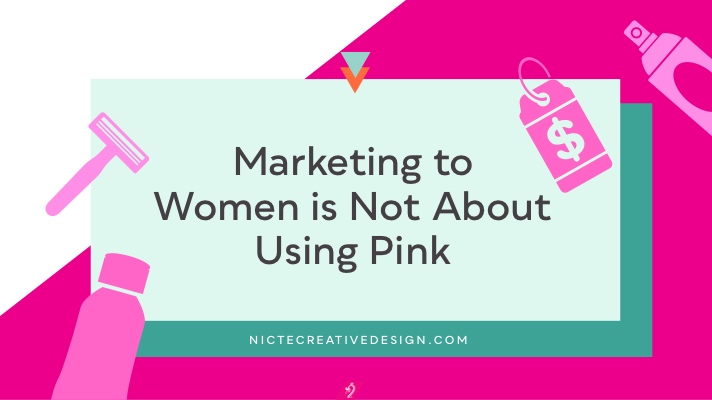Stereotyping is long gone.
Marketing to Women has certainly changed throughout time. Most women no longer dream of pink dresses and decor as they may have in the 1950’s. The days when baby girls were identified solely by pink is fading in our rear view mirror. Now pink is a lovely color, with lots of great hues. And there are some very effective ways to use it.

But today, women want to be treated as individuals, not stereotyped or generalized. Smart companies have noticed and are incorporating that into their campaigns, as in the US, women hold a purchase power of up to 15 trillion dollars! So it’s important to understand and apply this awareness to successfully engage women in your marketing.

Marketing to woman is Not about using pink
1. Pink is Not For Every Woman
There are exceptions, of course. Perhaps your brand or product is intentionally using pink to align with a cause or directive. An example that springs to most minds is The Susan G. Komen Foundation, proof that they’ve done an amazing job raising awareness for breast cancer with a specific pink color value. It’s been so well utilized through their marketing efforts that it connects to not only females but males, as many men now wear pink in support.
This is a fantastic example of matching the color to an intention and using it properly. The color grabs attention but pushes past gender specificity to become universally effective.
2. Avoid Negative Associations
Be aware that there’s a bit of a stigma to consider when using pink, known as the “pink tax.”
3. Create Compelling Content
To successfully market to women, it’s important to focus on where they’re spending their time online (for social media, it’s mostly Facebook, Instagram and Pinterest). But the key is to create effective content. Instead of relying on pink, utilize elements such as a memorable spokesperson, a relatable message and humor! A NewsCred study says that 70% of women share content that makes them laugh. And that means it grabs their attention to begin with, which is everything.
Here are three great examples:
The Harmon Brothers exemplify this. Take a gander at one of their brilliant marketing campaigns for the company PooPouri.
A well dressed woman with a proper British accent shares the humor behind making a trip to the bathroom and the ‘fragrance’ that can be left behind. It’s incredibly clever, hitting just the right note for the topic and product. It was wildly successful, creating product recognition and getting people to share, talk about and BUY it!
Here’s how the Harmon Brothers tackled personal odors by producing a hilarious musical about making woman — and men — smell extra fresh in a natural way thanks to the product, Lume deodorant.
To date, this generated 7 million views, 30k shares and sales were up by 526%! In both videos, women were targeted, without stereotyping and levity was brought to a very recognizable but somewhat taboo subject. Especially where females are concerned — and sold millions! Bravo!
This clever ad is for Chatbooks, an app created for busy mothers. They show how real motherhood is, through funny scenes where moms can completely relate. The comments were flooded by women saying: “How did you know!” and “This is my life!
Stellar! While the product certainly fills a need — a simple, affordable solution that moms would welcome — the campaign also solves the inherent obstacle of moms being too busy to have ever found it if not for the attention-grabbing ads on social media. And bonus — they are so validating and funny that they were shared like hotcakes, and that led to BIG sales!
4. Don’t Generalize
So we see how important it is to understand your audience when marketing to women. Their current wants, needs and challenges, what makes them tick, and what makes them buy. Using pink is not always the answer. There are too many factors that can influence how color is perceived and it’s affect on your viewer, whether it’s personal, cultural, social, or emotional.
These great examples make it seem almost a little silly to think that making pink products or packaging is the fallback to when marketing to women, especially with all their buying and sharing power. You don’t need to always think pink to lasso their attention. Instead, create campaigns that tap into the right combination of elements that make people want to share — which further spreads the word… and sells!
To learn how you can harness the power of color, download our FREE Color Trends Guide and maximize color to leverage your brand, product or service!



